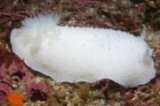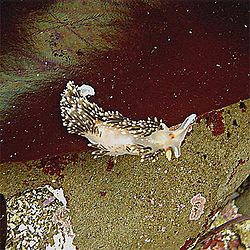
Doris odhneri
Encyclopedia
Doris odhneri is a species of sea slug, a dorid nudibranch
, a shell-less marine gastropod mollusk in the family Dorididae. It is known by many common names, such as: giant white nudibranch, giant white dorid, and white-knight nudibranch. It is also often referenced to as Ohner's dorid to honor Nils Hjalmar Odhner
, the scientist it is named after.

.
It is rarely found in the intertidal, and is more likely to be found in the subtidal to 75 ft.
Like most nudibranchs, Doris odhneri is hermaphroditic and mates with the right sides of the body together. Elegant ribbon-like egg masses are laid and attached to substrates. There are usually 8 to 12 eggs in each.
Nudibranch
A nudibranch is a member of what is now a taxonomic clade, and what was previously a suborder, of soft-bodied, marine gastropod mollusks which shed their shell after their larval stage. They are noted for their often extraordinary colors and striking forms...
, a shell-less marine gastropod mollusk in the family Dorididae. It is known by many common names, such as: giant white nudibranch, giant white dorid, and white-knight nudibranch. It is also often referenced to as Ohner's dorid to honor Nils Hjalmar Odhner
Nils Hjalmar Odhner
Nils Hjalmar Odhner was a Swedish zoologist who studied mollusks, a malacologist. During his lifetime he was professor of invertebrate zoology at the Swedish Museum of Natural History, Stockholm...
, the scientist it is named after.

Description
Doris odhneri is the largest nudibranch on the California coast, measuring up to 20 cm. It is completely white in color with no markings, however anomalies with a yellowish hue have been described in the Puget Sound region. A conspicuous characteristic of this nudibranch is its gill. It is composed of seven fluffy plumes and its rhinophores have 20 to 24 lamellae.Life Habits
Their diet consists of sponges, mostly HalichondriaHalichondria
Halichondria is a genus of marine demosponges belonging to the family Halichondriidae. These are massive, amorphous sponges with clearly separated inner and outer skeletons consisting of bundles of spicules arranged in a seemingly random pattern...
.
It is rarely found in the intertidal, and is more likely to be found in the subtidal to 75 ft.
Like most nudibranchs, Doris odhneri is hermaphroditic and mates with the right sides of the body together. Elegant ribbon-like egg masses are laid and attached to substrates. There are usually 8 to 12 eggs in each.

